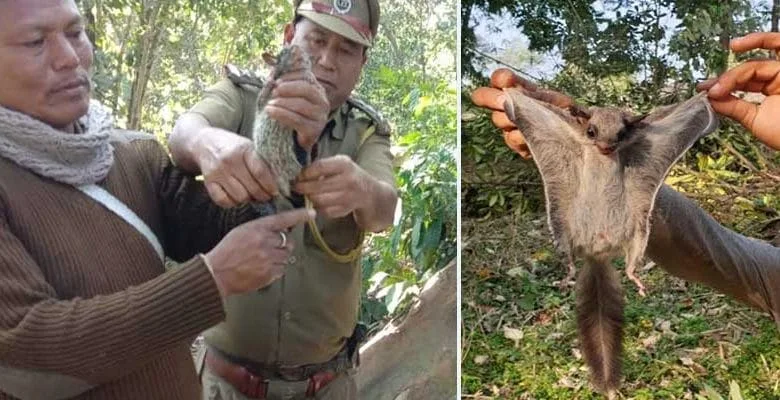Arunachal: Two rescued flying squirrels released in D. Ering Wildlife Sanctuary

PASIGHAT-(By-Maksam Tayeng ): Mibom Pangging of Namsing village under Mebo Sub-Division, has released Two flying squirrel at Sibiyamukh Wildlife Range of D. Ering Wildlife Sanctuary on Thursday in the presence of Domek Koyu, Range Officer and other staffs.
After releasing the two flying squirrels at Gul-Katoni area of Sibiyamukh Wildlife Range, Mibom Pangging said that he had rescued the squirrels from nearby his house from a fallen tree holes in Namsing village.
“On seeing the flying squirrels I caught them and decided to hand it over to the wildlife department, as, if others find it they will eat the squirrels. On informing the matter of rescue of squirrels, DFO Wildlife Tasang Taga directed Range Officer Sibiyamukh to release it to the wild.
Hence, I accompanied the Range officer and released the squirrels in DEWS today”, added Pangging who works as LDC in Namsing CO office and appeals to his youth friends to love and protect wildlife for a healthy environment and better coexistence between humans and animals.
Meanwhile, Range Officer, Sibiyamukh, Domek Koyu who received and released the squirrels at his range with the rescuer, informed that the pair of released squirrels will breed more of its species in the sanctuary.
He appreciated the noble initiative of Pangging and appealed to all others to do the same. While Divisional Forest Officer, Wildlife, Tasang Taga has welcomed the move of the youth and has said that, such action of some good hearted, animal loving persons, many others will learn something.
We need to save and protect our wildlife too for a healthy environment for our healthy livings, added Taga, appealing to other youths and villagers to love, preserve and protect our wildlife.
Flying squirrels are known for soaring anywhere from 150 to 500 feet, sailing from tree to tree to avoid ground predators—but they actually glide rather than fly. Flying squirrels don’t have their own means of propulsion, like a bird or bat, but glide using a furry membrane called the patagium that connects at their wrists down to their ankles. When they leap from a tree and spread their limbs, this flap of loose skin forms a square and acts like a hang glider.
Flying squirrels can turn by lowering one arm, while a specialized piece of cartilage not found in other gliding mammals extends from the wrist to support the pagatium and help them steer. These animals are capable of making 180-degree turns in mid-air to evade flying predators like owls.
Moving their hands and feet in opposite directions also helps flying squirrels direct their movements so they land safely on their strong, silent padded feet. Their long, fluffy tails stabilize their flight and flipping those tails up helps them put on the brakes.
There are about 50 species of flying squirrels ranging across most of North America down into Central America, and stretching from Southeast and Northern Asia into Siberia and Scandinavia. They make their homes in in woodpecker holes, nests abandoned by birds, or tree cavities in forests, woodlands, and jungles.
Almost half of flying squirrel species, such as the southern flying squirrel in North and Central America and the Javanese flying squirrel of Southeast Asia, have stable populations. Their elusive nature makes them hard to study so there’s little data on some species.
For those with decreasing populations—such as the endangered smoky flying squirrel of Southeast Asia—threats include destruction of their forest habitats by logging, other types of wood harvesting, and agricultural and residential development, according to the International Union for Conservation of Nature. Hunting and trapping are also threats to species such as Bhutan’s giant flying squirrel and the Northern Chinese flying squirrel.













